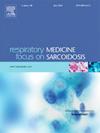临床实践中,血嗜酸性粒细胞计数和FeNO对贝那利单抗有效性的影响:一项ORBE II亚分析。
IF 3.5
3区 医学
Q2 CARDIAC & CARDIOVASCULAR SYSTEMS
引用次数: 0
摘要
背景:ORBE II研究显示了benralizumab治疗严重嗜酸性哮喘(SEA)的实际有效性。该亚组分析旨在根据基线血嗜酸性粒细胞计数(BEC)和/或呼出一氧化氮(FeNO)水平来描述患者和结果。方法:在ORBE II回顾性研究的分析中,接受benralizumab治疗的SEA患者根据单独或联合BEC/FeNO水平分为亚组,根据以下阈值:高BEC (hiBEC):≥300个细胞/μL;低BEC (loBEC):结果:大多数可获得数据的患者被分类为hiBEC(72.6%)和hiFeNO(38.3%)。根据联合基线BEC和FeNO水平的分布揭示了患者群体的异质性。虽然SEA的共同特征在亚组中是相同的,但也观察到一些明显的特征,包括hiBEC/loFeNO患者过敏性哮喘患病率升高,loBEC/loFeNO患者高肥胖患病率和不吸烟者较少,loBEC/hiFeNO患者严重加重率显著[5.5 SD (6.0)], hiBEC/loBEC亚组症状更严重。所有亚组在贝纳利珠单抗治疗后均显示获益,超应答率从68.2%到83.3%不等,临床缓解率达到70.0%。hiBEC/hiFeNO患者的反应特别好。结论:本研究显示了T2生物标志物在ORBE II SEA患者中的变异性,强调了高BEC值的普遍性。尽管无论BEC如何,benralizumab的益处都很重要,但高BEC预示着良好的结果,而FeNO对治疗效果的影响较小。本文章由计算机程序翻译,如有差异,请以英文原文为准。
The impact of blood eosinophil count and FeNO on benralizumab effectiveness in clinical practice: An ORBE II subanalysis
Background
The ORBE II study showed the real-world effectiveness of benralizumab in severe eosinophilic asthma (SEA). This subgroup analysis aimed to characterize patients and outcomes based on baseline blood eosinophil count (BEC) and/or fractional exhaled nitric oxide (FeNO) levels.
Methods
In this analysis of the ORBE II retrospective study, SEA patients receiving benralizumab were categorized into subgroups based on individual or combined BEC/FeNO levels, according to the following thresholds: high BEC (hiBEC): ≥300 cells/μL; low BEC (loBEC): <300 cells/μL; high FeNO (hiFeNO): ≥50 ppb; low FeNO (loFeNO): <50 ppb. Baseline and up to 1 year of follow-up data are described.
Results
Most patients with available data were classified as hiBEC (72.6 %) and 38.3 % as hiFeNO. The distribution according to combined baseline BEC and FeNO levels revealed a heterogeneous patient population. Although common SEA features were shared among subgroups, some distinct characteristics were observed, including elevated allergic asthma prevalence in hiBEC/loFeNO patients, high obesity prevalence and fewer non-smokers in loBEC/loFeNO patients, remarkable severe exacerbation rates in loBEC/hiFeNO patients [5.5 SD (6.0)], and more severe symptoms in the hiBEC/loBEC subgroup. All subgroups showed benefits following benralizumab treatment, with super-responder rates ranging from 68.2 % to 83.3 % and clinical remission rates reaching 70.0 %. Particularly good responses were noted in hiBEC/hiFeNO patients.
Conclusions
This study shows the variability of T2 biomarkers in ORBE II SEA patients, emphasizing the prevalence of high BEC values. While benralizumab benefits were important regardless of BEC, high BEC predicted good outcomes and FeNO had less influence on treatment effectiveness.
求助全文
通过发布文献求助,成功后即可免费获取论文全文。
去求助
来源期刊

Respiratory medicine
医学-呼吸系统
CiteScore
7.50
自引率
0.00%
发文量
199
审稿时长
38 days
期刊介绍:
Respiratory Medicine is an internationally-renowned journal devoted to the rapid publication of clinically-relevant respiratory medicine research. It combines cutting-edge original research with state-of-the-art reviews dealing with all aspects of respiratory diseases and therapeutic interventions. Topics include adult and paediatric medicine, epidemiology, immunology and cell biology, physiology, occupational disorders, and the role of allergens and pollutants.
Respiratory Medicine is increasingly the journal of choice for publication of phased trial work, commenting on effectiveness, dosage and methods of action.
 求助内容:
求助内容: 应助结果提醒方式:
应助结果提醒方式:


